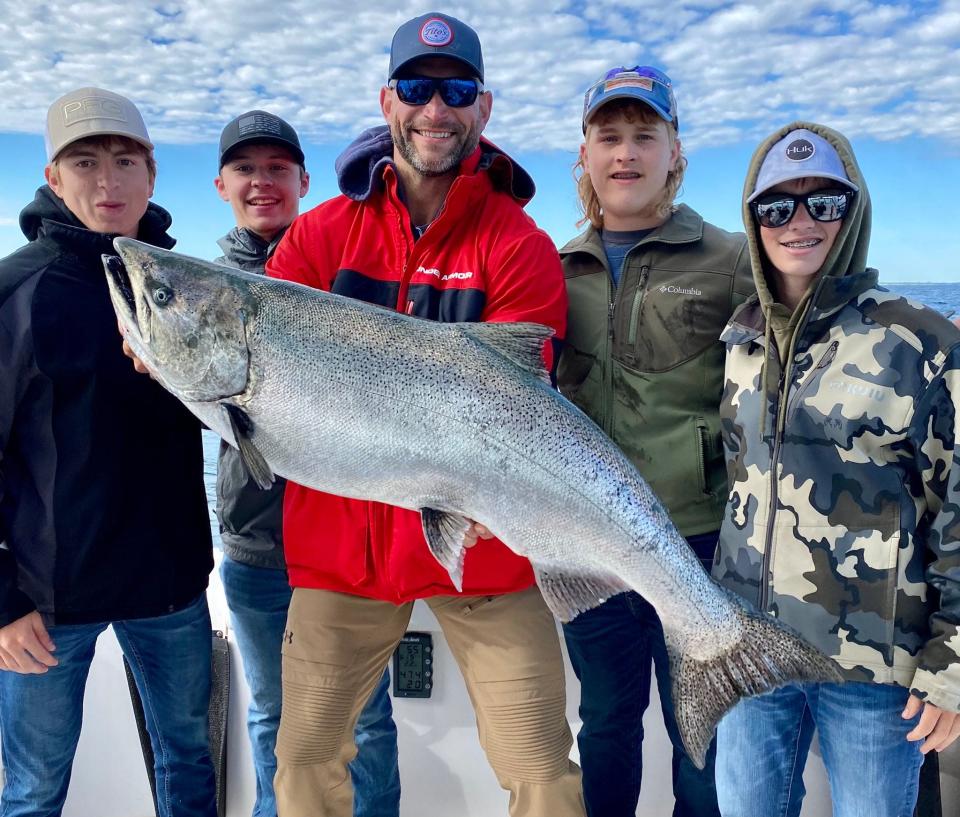The level of total prey fish in Lake Michigan is up, and that's good for salmon and trout
As Lake Michigan fisheries managers and stakeholders have approved chinook salmon stocking increases for this year, the latest prey fish assessment shows forage levels remain low historically but with some positive year-over-year changes.
Total biomass density of prey fish in 2022 equaled 8.7 kilograms/hectare, the highest value since 2013, according to bottom trawls conducted last fall in Lake Michigan by the U.S. Geological Survey.
That is good news for anglers as the overall amount of forage available to salmon and trout increased.
However, last year's data was well below the average of 34.3 kg/ha in the work dating to 1973, said Chuck Madenjian, a USGS fisheries biologist based in Michigan.
"That's what we've been seeing for a while now," Madenjian said. "Things may move up or down slightly but when you look back in time, the abundances are quite a bit lower than we used to see."
More: Outdoors calendar

Madenjian traveled to Sheboygan to share a draft version of the 2022 Lake Michigan prey fish assessment with the Wisconsin Federation of Great Lakes Sport Fishing Clubs on April 1.
Prey fish are sampled by the USGS in the lake by bottom trawl (annually since 1973) and acoustics (most years since 1992).
The data help form a portrait of the health of the lake, especially as it relates to food available for the millions of salmon and trout stocked in Lake Michigan annually.
Prey fish are down from historical levels due to both bottom-up and top-down effects, according to most scientists.
Less food is generally available to forage fish because of reduced phosphorous inputs to the lake and a massive invasion of zebra mussels and quagga mussels, filter-feeding organisms which remove plankton from the water column.
The small fish such as alewife and rainbow smelt are also subject to predation by predator fish such as chinook salmon and lake trout.
Madenjian said alwewife, long considered the key forage species, didn't change much from last year.
Mean biomass of yearling and older (YAO) alewife was 0.38 kg/ha in the spring bottom trawl, 0.10 in the fall bottom trawl and 3.0 kg/ha in the acoustical survey.
By comparison the fall alewife bottom trawl in 2017 was 0.02 kg/ha, lowest on record, and 0.54 kg/ha in 2018.
Some older (6 years old) alewife were captured in 2022, another good sign. But Madenjian said he still considers the alewife population "truncated," or with few older fish, likely due to heavy predation pressure.
Bloaters were the most abundant fish in the survey and showed 261 fish/ha in the fall bottom trawl, the highest value since 1990.
Other than that, there were no major changes, Madenjian said.
Wisconsin, Michigan and Indiana all are scheduled to increase stocking of chinook salmon this year. The Wisconsin DNR is planning to stock 1.3 million chinook salmon, up from 1.2 million in 2020-22, as well as 500,000 coho salmon, 460,000 steelhead, 450,000 brown trout and 50,000 brook trout, the same levels as in the previous plan.
Michigan is increasing its chinook stocking goal from 650,000 in 2022 to 1 million in 2023, while Indiana is nudging its plan up from 225,000 last year to 275,000.
Kid's free fishing clinics coming Saturday
The 38th annual Spring Fishing Clinics for Kids will be held Saturday at 11 sites in southeastern Wisconsin.
The clinics are free and staffed by volunteers with local fishing, conservation or civic clubs. They are sponsored by the Wisconsin Council of Sport Fishing Organizations, Milwaukee and Washington County Parks Departments, the Hunger Task Force Fish Hatchery and the Department of Natural Resources.
The events are geared to youth ages 15 and under and include instruction on fishing techniques, casting, safety, fish identification, rules and regulations and knot tying. Fishing equipment and bait will be provided, but anglers can bring their own gear. Some locations will have fish cleaning and cooking demonstrations.
Clinics begin at 9 a.m. and run through 3 p.m. The 10 sites in Milwaukee County are: Brown Deer Park, Dineen Park, Greenfield Park, Kosciuszko Park, McCarty Park, McGovern Park, Mitchell Park, Sheridan Park, Scout Lake and Washington Park. One clinic will be held at Regner Park in Washington County.
No pre-registration is necessary, but to accommodate groups of 20 or more, call (414) 416-0591.
Our subscribers make this reporting possible. Please consider supporting local journalism by subscribing to the Journal Sentinel at jsonline.com/deal.
DOWNLOAD THE APP: Get the latest news, sports and more
This article originally appeared on Milwaukee Journal Sentinel: Increase in Lake Michigan forage fish good for salmon, trout fishery

